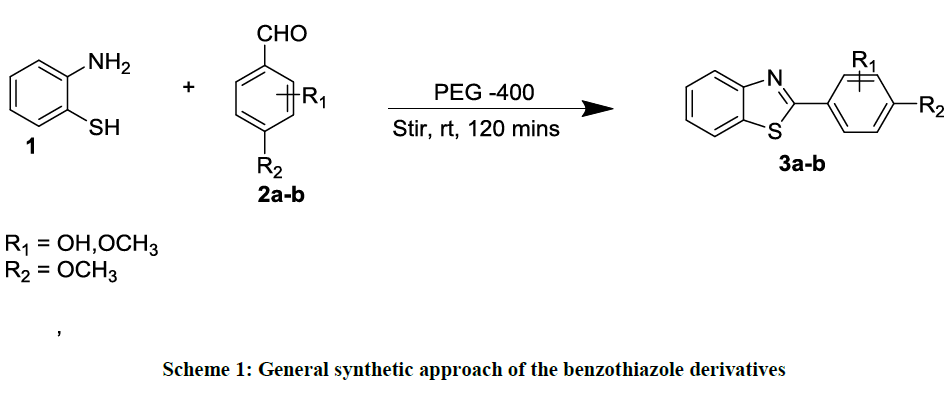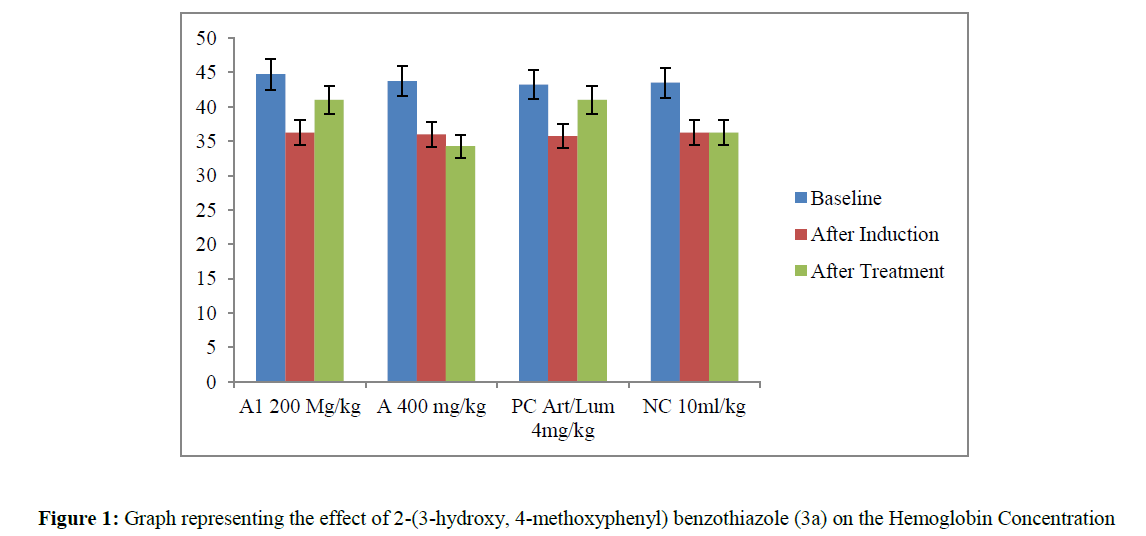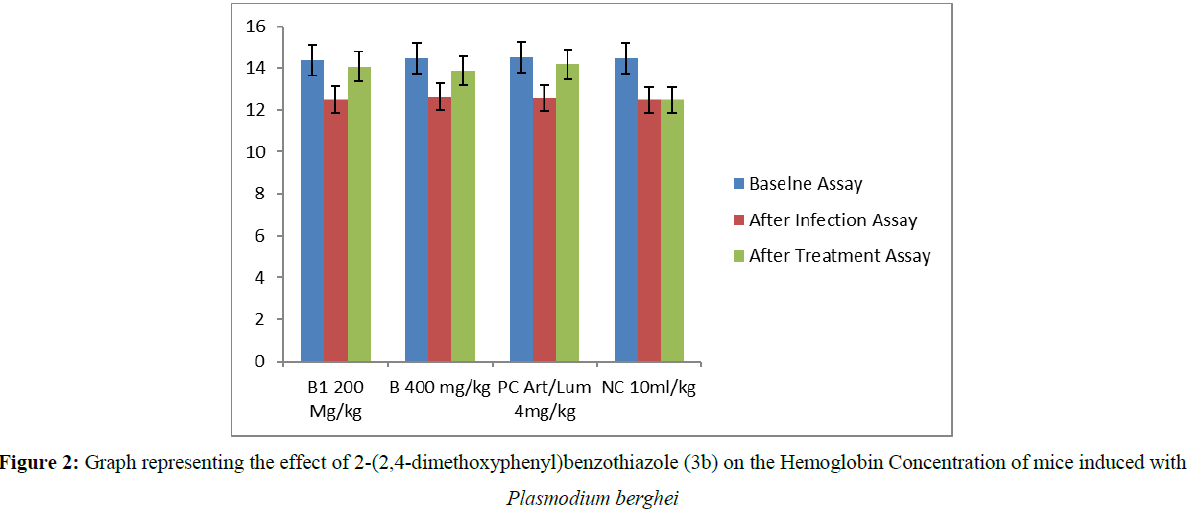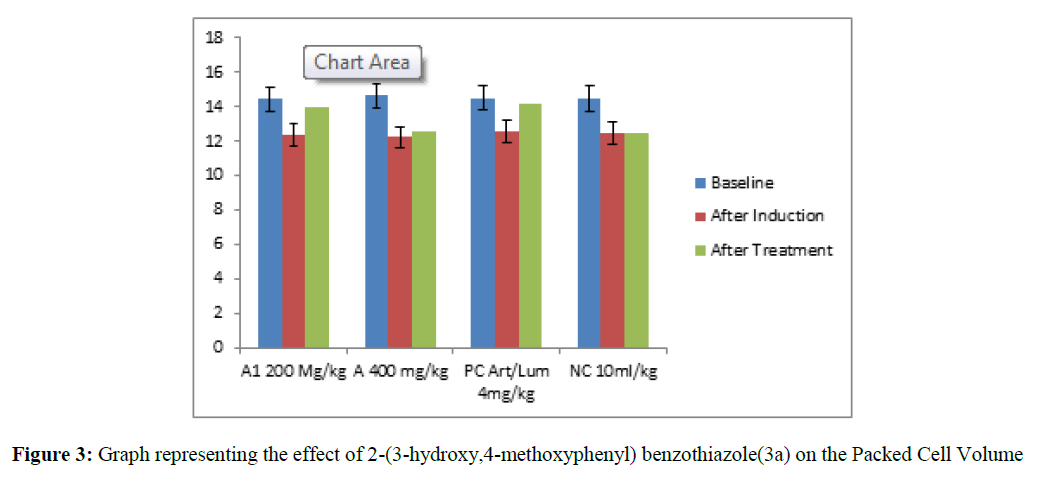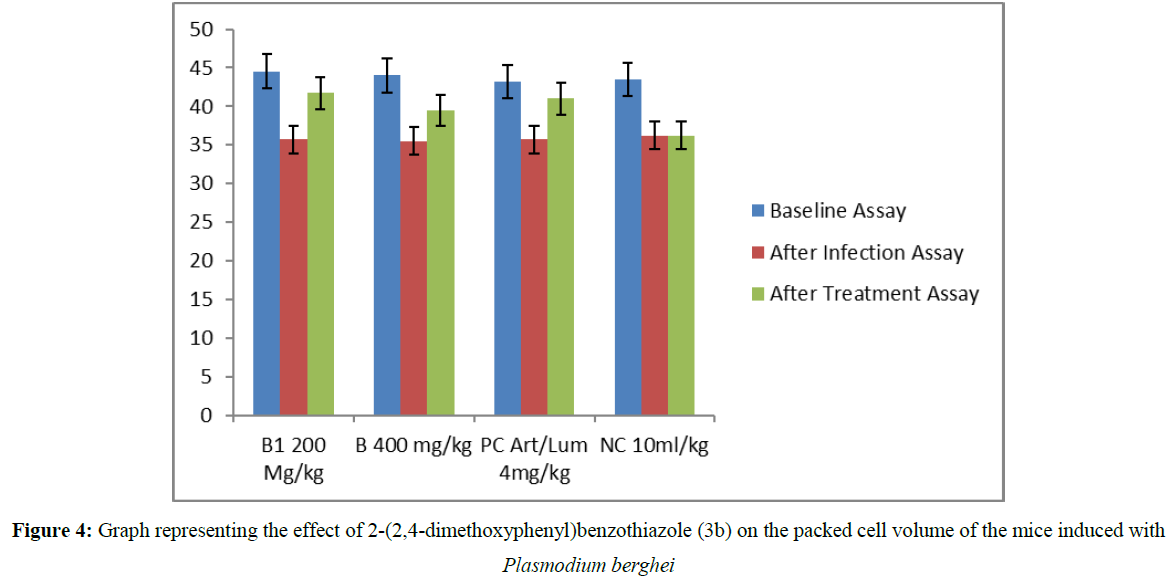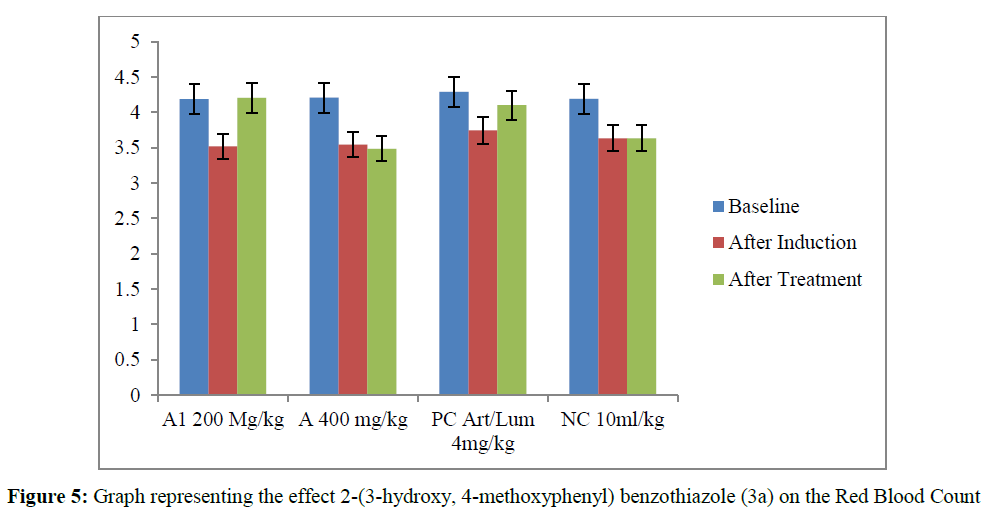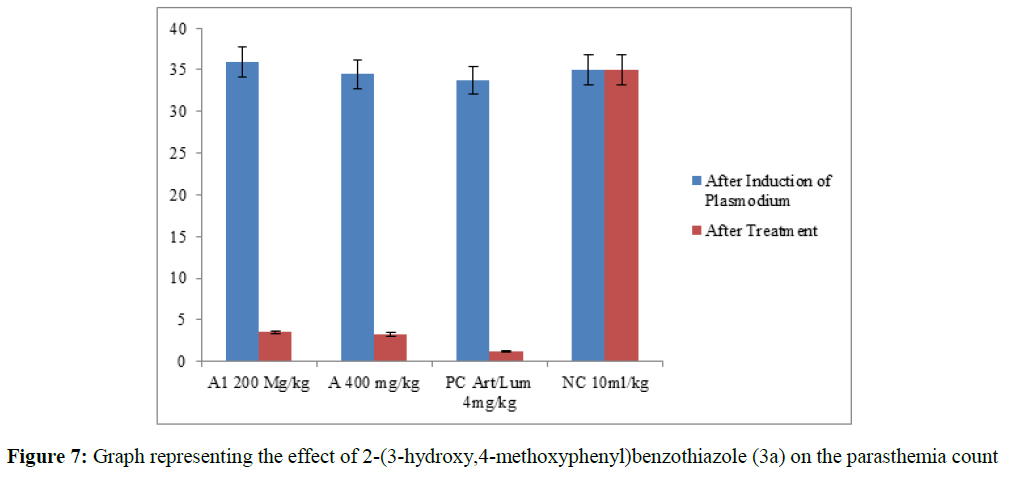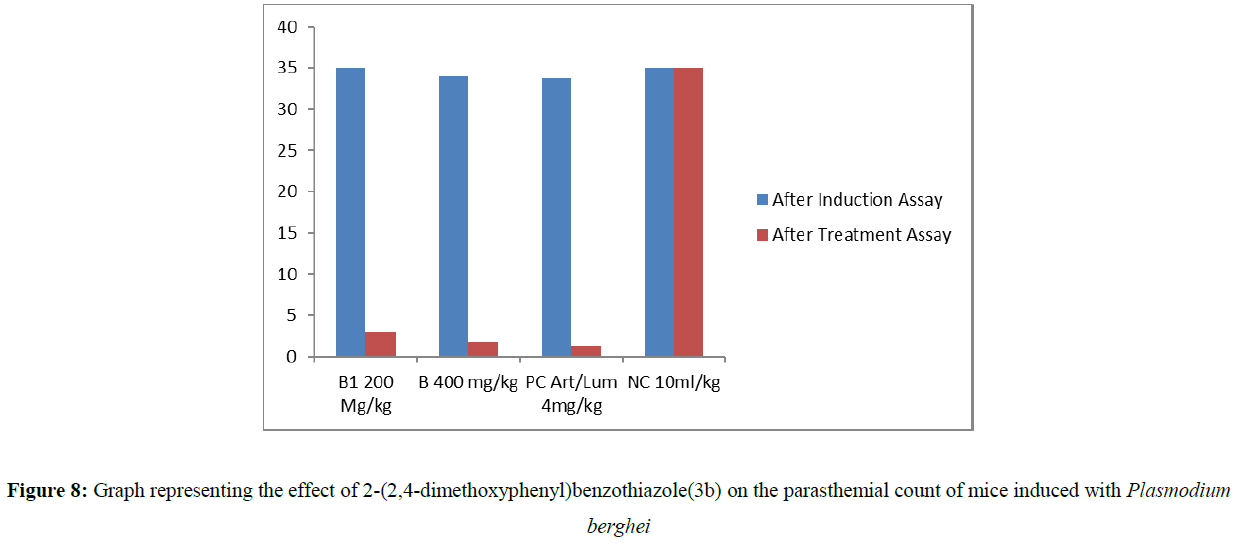Research Article - Der Pharma Chemica ( 2023) Volume 15, Issue 4
BENZOTHIAZOLE DERIVATIVES AS A POTENTIAL ANTIMALARIA DRUG
Vivian Ifeoma Okonkwo1, Chinedu Emmanuel Nnadi1, Cosmas Chinweike Eze2,3, Faith Elijah Temitope4 and Ebuka Leonard Onyeyilim4,5*2Natural Science Unit, School of General Studies, University of Nigeria, Nsukka, Nigeria
3Department of Chemistry, North Carolina State University, Nigeria
4Department of Pure and Industrial Chemistry University of Nigeria, Nsukka, Nigeria
5Department of Chemistry, University of Iowa, Nigeria
Ebuka Leonard Onyeyilim, Department of Pure and Industrial Chemistry University of Nigeria, Nsukka, Nigeria, Email: onyeyilimebuka@gmail.com
Received: 23-Jun-2023, Manuscript No. dpc-23-103590; Accepted Date: Jul 18, 2023 ; Editor assigned: 26-Jun-2023, Pre QC No. dpc-23-103590; Reviewed: 10-Jul-2023, QC No. dpc-23-103590; Revised: 14-Jul-2023, Manuscript No. dpc-23-103590; Published: 21-Jul-2023, DOI: 10.4172/0975-413X.15.4.54-63
Abstract
Plasmodium berghei is transmitted by Anopheles mosquitoes and it infects the liver after being injected into the bloodstream by a bite of an infected female mosquito. We have reported the synthesis of benzothiazole derivatives (compound 3a-b) by condensing 2-aminothiophenol with different aromatic aldehydes in polyethylene glycol-400 and the progress of the reaction was monitored using thin-layer chromatography, with dichloromethane and n-hexane used as a developing solvent in the ratio of 2:1. The synthesized compound was characterized by 13C-Nuclear Magnetic Resonance and 1H- Nuclear Magnetic Resonance. The acute toxicity of the synthesized compound was evaluated and found to be less toxic. The antimalarial activity of the compound was also studied in-vitro using albino mice and the result showed that the compound has significant antimalarial activity against Plasmodium berghei.
Keywords
Synthesis; Benzothiazole; Haematological assay; Antimalarial; Parasitamia
INTRODUCTION
Malaria is one of the dangerous diseases in the world, as well as a major cause of morbidity and mortality in people living in tropical countries [1]. It is a life-threatening disease caused by Plasmodium species parasites transmitted to humans through infectious bites of female Anopheles mosquitoes [2]. Malaria is endemic in more than 90 countries, affecting approximately 40% of the world’s population [3]. Malaria remains one of the major public health problems and a major cause of illness, hospitalizations, and deaths in Nigeria. Research shows that Nigeria is a malariaendemic area where 97% of the Nigerian population is at risk of contracting malaria [4-7]. Several antimalarial drugs have been synthesized for the treatment and prevention of the disease but the development of resistance by the parasites has led to the inefficiency of some of these drugs. Therefore, it is essential to find novel antimalarial drug which has high pharmacological effectiveness instead of what is obtainable presently. Benzo-thiazoles analogues are of interest due to their potential activity against malarial and microbial infections [8].
Benzothiazole are classes of organic compound characterized with the basic skeleton (C7H5NS). They belong to the family of bicyclic heterocyclic compounds having benzene nucleus fused with five-membered ring comprising nitrogen and sulfur atoms. 2-substituted benzothiazole has emerge in its usage as a core structure in the diversified therapeutically applications. The study of structure-activity relationship interestingly reveals that change of the structure of substituent group at C-2 position commonly results to change of its bioactivity [9]. Benzothiazole and their Schiff bases are very important biological compound with reference to various biological activities such as antimicrobial [10-14], anticancer [15-18],antihelminthic [19],anti-diabetic activities [20], anti-tubercular [21-22], anti-malaria [23], anticonvulsant [24-25], analgesic [26] ,anti-inflammatory [27], antitumor [28] anti-viral [29-30], anti-oxidant [31], anti-glutamate and anti-parkinsonism [32], muscle relaxant activities [33], neuroprotective [34], inhibitors of several enzymes [35]. With increase in the number of malaria cases recorded worldwide, especially in Africa, and due to the resistance of these parasites to malaria drugs, there is need to synthesize new compounds with antimalarial activity that will not only suppress the parasite but serve as a curative drug and other promising gateway to other future discoveries.
METHODOLOGY
2-aminothiophenol (16mmol) was reacted with different benzealdehyde (16 mmol,) in polyethylene glycol-400 (20ml). The mixture was stirred using a magnetic stirrer at room temperature for 120 minutes and a solution with a yellow color was obtained. The progress of the reaction was monitored using TLC. Dichloromethane and n-hexane were used as the developing solvent in the ratio of 2:1. Upon completion of the reaction, the mixture was poured into ice and then extracted with 50ml of diethyl ether. The mixture was poured into a separating funnel and shook for proper extraction and then the two phases were separated. The ethereal extracted was collected in a beaker and heated to obtain the crude product which was purified by recrystallization using ethanol as solvent.
Determination of Acute toxicity of benzothiazole derivatives (3a-b)
The oral acute toxicity of the Benzothiazole derivatives was estimated in albino mice as described by Lorke (1983). A total of 12 mice weighing (12.89 – 17.94 g) were used for the study. The experiment was conducted in two phases. The first phase was for 10, 100 and 1000 mg/kg while the second phase was for 1600, 2900, and 5000 mg/kg orally administered. The animals were starved for 18 hours before administration of the test sample. In the first phase, three groups of three (3) animals each received 10, 100, and 1000 mg/kg respectively. The animals were monitored for 24 hours for behavioral changes and death. None of the animal died in the first groups. So, the second phase was introduced. The animals for each group received 1600, 2900, and 5000 mg/kg respectively and were monitored as in the first phase.
Determination of Antimalarial activity of benzothiazole derivatives (3a-b)
Plasmodium berghei was used to test for the antimalarial activity of benzothiazole derivatives (3a-b). The parasites were sustained through weekly blood passage from infected mice to uninfected mice kept in the laboratory. A total of 20 mice weighing between 11.77- 14.37 g were used for the study.
The animals were fed with standard rats’ chow and tap water. The 20 mice were grouped into four groups of five (5) animals each. Group A and B are for the test sample, received 200 and 400 mg/kg respectively. Groups C and D were for the positive control (Standard drugs- Artemether & Lumefantrine 4 mg/kg) and negative control (water) respectively.
Their blood samples were collected at this stage and the hematological indices (HB, RBC and PCV) were analyzed to obtain their baseline values. All the animals were passaged with Plasmodium berghei and left for 72 hours for the development of a full malarial parasite load. At the end of the 72 hours, their blood samples were collected. An EDTA bottle containing EDTA was used to store the blood sample for various hematological assays.
After 72 hours, drug administration started. The mice in groups A & B received 200 mg/kg and 400 mg/kg of compound (3a-b) respectively while groups C and D received 4 mg/kg of (Artemether &Lumefantrine) and (water) respectively daily for 3 days. On day four, their blood samples were collected and analyzed for the effectiveness of the treatment.
Collection of the Blood samples
The blood samples were collected in two different ways for the experiment. Inserting a heparinized hematocrit capillary tube through the retro-plexus vein (ocular puncture) of the rats and collecting the blood samples into a bottle containing EDTA. Cutting the tips of the rat tails with sharp scissors and collecting their blood samples on a slide.
Determination of Parasitemia count of the blood samples
A thin blood film was prepared with the blood obtained from the rats’ tails, fixed with methanol, air-dried, and stained with Giemsa. The stain was washed with water and allowed to air dry. This was followed by viewing the slides in a microscope to count the damaged cells.
Determination of Packed Cell Volume (PCV)
A hematocrit capillary tube was filled with blood obtained from the retro-plexus vein by placing one of the open ends of the tube in the blood bottle and tilting it at an angle of about 30°C.One end of the filled capillary tube was sealed with a plastercine and the tube was allowed to centrifuged for 20 minutes at 300 rpm in a hematocrit centrifuge. A hematocrit reader was used to read off the length of the packed cell in percentage.
Interpretation of spectral for compound (3a-b)
1H NMR spectrum of 2-(3-hydroxyl-4-methoxyphenyl) benzothiazole (3a) The proton at C1 is assigned the peak δ8.10, the protons at C2 and C3 are both assigned the peak δ8.08δ8.09 is the proton at C4, δ7.98 is assigned to the proton at C9, δ9.54 is assigned to the proton attached to the O of the hydroxyl group. The proton at C12 is assigned the peak δ7.09, the proton attached to C13 is assigned the peak δ7.98 and δ3.81 is assigned to the protons at C14.
13C NMR spectrum of 2-(3-hydroxyl-4-methoxyphenyl) benzothiazole (3a)
The four aromatic carbons, C1, C2, C3, C4are assigned the peaks δ122.6, 125.5, δ126.1 and δ122.8 respectively. C5 is assigned the peak δ134.6, C6 is assigned the peak δ154.1, C7 is assigned the peak δ167.74 and C8 is assigned the peak δ126.9. The peak δ112.8 is assigned to C9, δ147.4 is assigned to C10, δ151.1 is assigned to C11 and δ114.0 is assigned to C12. C13 is assigned the peak δ119.5 and the methoxy carbon, C14 is assigned the peak δ56.1.
1H NMR spectrum of 2-(2, 4-dimethoxyphenyl) benzothiazole (3b)
The proton at C1 is assigned the peak δ8.23the protons at C2 and C3 are both assigned the peak δ7.55, δ8.12 is assigned to the proton at C4, δ6.34 is assigned to the proton at C10, δ6.39 is assigned to the proton at C12.The proton at C13 is assigned the peak δ7.26, the proton attached to the both methoxygroup are assigned the peak δ3.73.
13C NMR spectrum of 2-(2, 4-dimethoxyphenyl) benzothiazole (3b)
The four aromatic carbons, C1, C2, C3, C4 are assigned the peaks δ122.1, 125.1, δ125.8 and δ122.7 respectively. C5 is assigned the peak δ133.9, C6 is assigned the peak δ153.5, C7 is assigned the peak δ171.4 and C8 is assigned the peak δ114.4. The peak δ161.5 is assigned to C9, δ100.2 is assigned to C10, δ163.0 is assigned to C11 and δ106.9 is assigned to C12. C13 is assigned the peak δ129.0, the methoxy carbon, C14 is assigned the peak δ56.3, and the methoxy carbon, C15 is assigned the peak δ56.0.
Antimalarial and Hematological indices of the Mice induced with Plasmodium Berghei
Baseline analysis
There is no statistical difference between the negative control and the test sample/positive control of the haematological parameters. This analysis is to establish the baseline or the normal haematological indexes before the animal were infected with Plasmodium berghei
There is no statistical difference between the negative control and the test sample/positive control of the haematological parameters. This analysis is to observe the effect of the plasmodium on haematological indexes before treatment ensues.
The result showed that all the haematological parameters decreases with increasing dosage except the parasthemia count which has a dose dependent statistically significant improvement for the test samples (200 and 400 mg/kg) and the standard when compared with the negative control group.
Summary of the effect of Compound (3a-b) on Hemoglobin concentration
Summary of the effect of Compound (3a-b) on Packed Cell Volume
Summary of the effect of 2-(3-hydroxy,4-methoxyphenyl)benzothiazole on Red Blood Count
Summary of the effect of Compound (3a-b) on parasthemia count
DISCUSSION
Antimalarial activity of benzothiazole derivatives on mice infected with Plasmodium berghei This work presents the anti-malarial activity of benzothiazole derivatives (3a-b). Benzothiazole derivatives have been reported to have diverse Chemical reactivity and a broad spectrum of biological activity such as antitumor [36-37], antimicrobial [38], analgesic [39], anti-inflammatory[40], Antimalarial [8] However, its antimalarial activity has been poorly investigated [1].
The results obtained in Tables [2-8] shows the analysis of the parasthemia count and haematological indices. The baseline values obtained from Table 2 show that before the mice were passaged with the plasmodium berghei, their haematological indices (HB, RBC, PCV) were all normal hence there were no differences from the negative control.
| Compound | R1 | R2 | Molecular formulae | Molecular weight(g/mol) | Melting point | % Yield | Rf value |
| 3a | OH | OCH3 | C14H11O2NS | 257 | 156-160 | 84.1 | 0.67 |
| 3b | OCH3 | OCH3 | C15H13O2NS | 271 | 118-120 | 69.4 | 0.64 |
Four days after inoculation, their blood samples were collected and analyzed and it was seen that their parasthemia count increased significantly (30-40%) implying that the animals were now infected with malarial parasite hence manifested every sign and symptom including the reduction of the haematological indices just as with other kinds of disease condition Table 3.This result confirms documented reports about the effect of malaria Parasite on hematological parameter (HB, RBC, PCV) as reported by [41-42], who stated that changes in haematological parameter are likely to be Influenced by any disease condition including diseases such as malaria that can affect the health of mankind with various clinical presentation. After three days of treatment, their blood samples were collected and analyzed. Compound 3b shows a better antimalarial activity than compound 3a in terms of their effectiveness in their haematological indices when compare with standard drug (Artemether &Lumefantrine). However, compound 3a showed a better activity than 3b in terms of reduction in the parasthemia count.
| Sample | Hb | PCV | RBC |
|---|---|---|---|
| A1 200 Mg/kg | 14.4500±.21794 | 44.7500±1.03078 | 44.7500±1.03078 |
| B1 200 mg/kg | 14.6250±.13769 | 44.5000±1.50000 | 4.1650±.03524 |
| A 400 mg/kg | 14.6250±.13769 | 43.7500±.47871 | 4.2075±.05907 |
| B 400 mg/kg | 14.4750±.10308 | 44.0000±.70711 | 4.1050±.08723 |
| Art/Lum 4 mg/kg | 14.5000±.12910 | 43.2500±.85391 | 4.2900±.13934 |
| NC 10 ml/kg | 14.4750±.10308 | 43.5000±1.25831 | 4.1925±.05105 |
| Sample | Hb | PCV | RBC | Parasthemia count |
|---|---|---|---|---|
| A1 200 Mg/kg | 12.35±.19365 | 36.25±.75000 | 3.5200±.13832 | 36.0±2.82843 |
| B1 200 mg/kg | 12.50±.24833 | 35.75±1.10868 | 3.5250±.05439 | 35.0±2.73861 |
| A 400 mg/kg | 12.22±.30104 | 36.00±1.08012 | 3.5425±.21336 | 34.5±2.72336 |
| B 400 mg/kg | 12.63±.2561 | 35.50±1.32288 | 3.5125±.11324 | 34.0±.70711 |
| Art/Lum 4 mg/kg | 12.580±.2 | 35.75±1.54785 | 3.7450±.08382 | 33.8±3.11916 |
| NC 10 ml/kg | 12.45±.22500 | 36.25±1.03078 | 3.6350±.15516 | 35.0±2.67706 |
| Sample | Hb | PCV | RBC | Parasthemia count |
|---|---|---|---|---|
| A1 200 Mg/kg | 13.95±.06455* | 41.00±.91287* | 4.2050±.03379* | 3.5000±.86603* |
| B1 200 mg/kg | 14.08±.13769* | 41.75±1.10868* | 4.1850±.07489* | 3.0000±.40825* |
| A 400 mg/kg | 12.58±.55132* | 34.25±1.9311* | 3.4850±.25194* | 3.0000±.40825* |
| B 400 mg/kg | 13.88±.17017* | 39.50±1.55456* | 4.0550±.04555* | 1.7500±.25000* |
| Art/Lum 4 mg/kg | 14.18±.08539* | 41.00±.91287* | 4.1025±.01887* | 1.2500±.47871* |
| NC 10 ml/kg | 12.48±.22500 | 36.25±1.03078 | 3.6350±.15516 | 35.0002±.67706 |
| Compound/dosage | Hb 1(Baseline) | Hb 2(After induction) | Hb 3(After treatment) | D | %D |
| A1 200 mg/kg | 14.45 | 12.35 | 13.95 | 1.6 | 11.47 |
| B1 200 Mg/kg | 14.37 | 12.5 | 14.08 | 1.58 | 11.22 |
| A 400 mg/kg | 14.62 | 12.22 | 12.58 | 0.36 | 2.86 |
| B 400 mg/kg | 14.47 | 12.63 | 13.88 | 1.25 | 9 |
| Art/Lum 4 mg/kg | 15.5 | 12.58 | 14.18 | 1.6 | 11.28 |
| NC 10 ml/kg | 14.47 | 12.45 | 12.48 | 0.03 | 0.24 |
| Compound/dosage | PCV 1 (Baseline) | PCV 2 (After induction) | PCV 3 (After treatment) | D | %D |
| A1 (200 mg/kg ) | 44.45 | 36.25 | 41 | 4.75 | 11.59 |
| B1 (200 Mg/kg ) | 44.5 | 35.75 | 41.75 | 6 | 14.37 |
| A (400 mg/kg) | 43.75 | 36 | 34.25 | -1.75 | -5.11 |
| B (400 mg/kg) | 44 | 35.5 | 39.5 | 4 | 10.12 |
| Art/Lum (4 mg/kg) | 43.25 | 35.75 | 41 | 5.25 | 12.8 |
| NC (10 ml/kg) | 14.47 | 12.45 | 12.48 | 0.03 | 0.24 |
| Compound/dosage | RBC 1 (Baseline) | RBC 2 (After induction) | RBC 3(After treatment) | D | %D |
| A1 (200 mg/kg ) | 4.18 | 3.52 | 4.2 | 0.68 | 16.19 |
| B1 (200 Mg/kg ) | 4.16 | 3.52 | 4.18 | 0.66 | 15.78 |
| A (400 mg/kg) | 4.2 | 3.54 | 3.48 | -0.06 | -1.72 |
| B (400 mg/kg) | 4.1 | 3.51 | 4.05 | 0.54 | 13.33 |
| Art/Lum (4 mg/kg) | 4.29 | 3.74 | 4.1 | 0.36 | 8.78 |
| NC (10 ml/kg) | 4.19 | 3.63 | 3.63 | 0 | 0 |
| Compound/dosage | Parasthemia count 1 (After induction) | Parasthemia count 2 (After treatment) | D | %D |
| A1 200 Mg/kg | 36 | 3.5 | 32.5 | 90.28 |
| B1 200 mg/kg | 35 | 3 | 32 | 91.42 |
| A 400 mg/kg | 34.5 | 3.25 | 31.25 | 90.58 |
| B 400 mg/kg | 34 | 1.75 | 32.25 | 94.85 |
| Art/Lum 4mg/kg | 33.8 | 1.25 | 32.55 | 96.3 |
| NC 10ml/kg | 35 | 35 | 0 | 0 |
CONCLUSION AND RECOMMENDATION
This study shows the synthesis of benzothiazole derivatives using a simple one-pot synthesis, characterization, and its physical properties. The in- Vitro antimalarial activity of the compound was also studied using albino mice induced with Plasmodium berghei. The haematological indices of the mice were monitored during the experiment as well as the parasitemia count. The results obtained showed that the synthesized compound Possesses Antimalarial activity and it is less toxic. This research is self-funded and is limited to two derivatives due to lack of funding. Therefore there is a need to explore other heterocycles containing benzothiazole moieties and investigate their activity against some biological targets.
REFERENCES
- Hout S, Azas N, Darque A et al.,Parasit.2004, 129:p.525-542.
- Dian ND, Rahim MAFA, Chan S et al., International Journal of Environmental Research and public Health.2022, 19:p.7888
- Garcia LS. Malaria. Clin Lab Med. 2010, 30:p.93-129.
- Guinovart C, Navia MM, Tanner M. Curr Mol Med. 2006, 6:p.137-140.
- Cox-Singh J, Davis TM, Lee KS. Clin Infect Dis.2008, 46(2):p.165-171.
- Leader K, Tong S, Weld L. Clin Infect Dis.2006, 43:p.1185-1193.
- Obieche OA, Odili VU. The Malaria World Journal.2016, 7(12).
- Sampark ST, Parth T, Arabinda R et al., Bioorganic & Medicinal Chemistry. 2017, 25:p. 5396-5406.
- Sarkar S. Istanbul J Pharm. 2018, 48:p. 28-31.
- Gupta S, Ajmera N, Gautam N et al., Ind J Chem. 2009, 48B:p.853-858.
- Kumbhare RM, Ingle VN. Ind J Chem. 2009, 48B:p. 996-1000.
- Murthi Y, Pathak D. J Pharm Res. 2008, 7:p. 153-155.
- Rajeeva B, Srinivasulu N, Shantakumar S. E Journal of Chemistry. 2009, 6:775-779.
- Maharan M, William S, Ramzy F et al., Molecules.2007, 12:p. 622- 633.
- Kini S, Swain S, Gandhi A. Ind J Pharm Sci. 2007, p. 46-50.
- Stanton HLK, Gambari R, Chung HC et al., Bio Org Med Chem. 2008, 16:p. 3626- 3631.
- Wang M, Gao M, Mock B et al., Bioorg Med Chem. 2006, 14:p. 8599-8607.
- Hutchinson I, Chua MS, Browne HL et al., J Med Chem. 2001, 44:p. 1446-1449.
- Sreenivasa M, Jaychand E, Shivakumar B et al., Arch Pharm Sci and Res. 2009, 1(2):p. 150-157.
- Pattan S, Suresh C, Pujar V et al., Ind J Chem. 2005, 44B:p. 2404-2408.
- Telvekar VN, Bairwa VK, Satardekar K et al., Bio Org Med Chem Lett. 2012, 22:p. 649-652.
- Patel RV, Patel PK, Kumari P et al., Chikhalia Eur J Med Chem. 2012, 53:p. 41-51.
- Venugopala KN, Krishnappa M, Nayak SK et al., Eur J Med Chem.2013, 65:p. 295-303.
- Ugale VG, Patel HM, Wadodkar SG et al., Eur .J.Med.Chem.2012, 53, 107-113.
- Zablotskaya A,Segal I, Geronikaki A et al., Eur J Med Chem. 2013, 70:p. 846-856.
- Azam MA, Dharanya L, Mehta CC et al., Acta Pharm. 2013, 63:p. 19-30.
- Praveen C, Kumar AN, Kumar PD. J Chem Sci. 2012, 124:p. 609-624.
- Henary M, Paranjpe S, Owens EA. Heterocycl Comm.2013, 19:p. 89-99.
- Vicini P, Gernoikaki A, Incerti M et al., Bioorg Med Chem. 2003, 11:p. 4785-4789.
- Nagarajan SR, Crescenzo GA, Getman DP et al., Bioorg Med Chem. 2003, 11:p. 4769-4777.
- Cressier D, Prouilla C, Hernandez P et al., Bio org Med Chem. 2009, 17:p.5275-5284.
- Jimonet P, Audiau F, Barreau M et al., J Med Chem. 1999, 42:p. 2828-2843.
- Rajeeva B, Srinivasulu N, Shantakumar SM. J Chem. 2009, 6:p. 775-779.
- Danzeisen R, Schwalenstoecker B, Gillardon F et al., J Pharmacol Exp Ther.2006, 316:p.189-199.
- Mylari BL, Larson ER, Beyer TA et al., J Med Chem. 1992, 22:p.108-122.
- Moustafa T, Nadia S, Eman R et al., European Journal of Medicinal Chemistry. 2014, 85:p. 576-592.
- Bradshaw TD, Shi D, Wrigley S et al., Journal of Medicinal Chemistry, 1996, 39:p. 3375.
- Latrofal A, Carottil A. European Journal of Medicinal Chemistry. 2016,31:p. 575-587.
- Kaur H, Kumar S, Singh I et al., DigestJournal of Nanomaterials and Biostructures. 2010, 5:p. 67-76.
- Oketani K, Nagakura N, Harada KT. European Journal of Pharmacology. 2001, p. 422.
- Kotepui M, Phunphuech B, Chupeerach C. Malaria Journal. 2014, 13-218.
- Aggarwal R, Chaturvedi V, Singh SK et al., Medico-legal Update. 2020, 20:p. 473-477.
Indexed at , Google Scholar , Crossref
Indexed at , Google Scholar , Crossref
Indexed at , Google Scholar , Crossref
Indexed at , Google Scholar , Crossref
Indexed at , Google Scholar , Crossref
Indexed at , Google Scholar , Crossref
Indexed at , Google Scholar , Crossref
Indexed at , Google Scholar , Crossref
Indexed at , Google Scholar , Crossref
Indexed at , Google Scholar , Crossref
Indexed at , Google Scholar , Crossref
Indexed at , Google Scholar , Crossref
Indexed at , Google Scholar , Crossref
Indexed at , Google Scholar , Crossref
Indexed at , Google Scholar , Crossref
Indexed at , Google Scholar , Crossref
Indexed at , Google Scholar , Crossref
Indexed at , Google Scholar , Crossref
Indexed at , Google Scholar , Crossref
Indexed at , Google Scholar , Crossref
Indexed at , Google Scholar , Crossref
Indexed at , Google Scholar , Crossref
Indexed at , Google Scholar , Crossref
Indexed at , Google Scholar , Crossref
Indexed at , Google Scholar , Crossref
Indexed at , Google Scholar , Crossref
Indexed at , Google Scholar , Crossref
Indexed at , Google Scholar , Crossref
Indexed at , Google Scholar , Crossref
Indexed at , Google Scholar , Crossref
Indexed at , Google Scholar , Crossref
Indexed at , Google Scholar , Crossref
Indexed at , Google Scholar , Crossref

